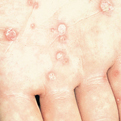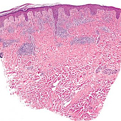Secondary Syphilis
General Information
Secondary Syphilis is characterized by skin rashes and mucous membrane lesions. Additional symptoms that may present themselves during the secondary stage include fever, loss of appetite, muscle aches, joint pain, enlarged lymph nodes and sore throat. This stage usually presents within 2 – 10 weeks after the the primary stage of syphilis. Around a third of individuals that are left untreated after contacting primary syphilis will develop secondary syphilis. Syphilis is primarily spread through sexual contact but can be spread through exposure to blood and can infect a baby transplacentally. Syphilis is cured easily during the early stages; an intramuscular injection of penicillin will cure an individual that has had syphilis for less then a year. Additional injections are needed for individuals that have syphilis for longer then a year. Alternative medication is available for patients that are allergic to penicillin
Epidemiology
3.3 cases per 100,000 population for Primary and Secondary syphilis in United States in 2006, an increase of 11.8% from 2005
Etiology
Sexually transmitted disease caused by the bacterium Treponema pallidum, can also be acquired by exposure to blood
Pathogenesis
Secondary to chancre sore is the development of a rash on one or more areas of the body
Clinical
Rough, round, discrete, reddish brown macules measuring approximately 5 mm in diameter
Histology
Hyperkeratosis of the epidermis, capillary proliferation with endothelial swelling in the superficial corium, and transmigration of polymorphonuclear neutrophils. In the deeper dermis, perivascular infiltration by monocytes, plasma cells, and lymphocytes occurs.
Bibliography
1. “Syphilis – CDC Fact Sheet” (Online). http://www.cdc.gov/std/syphilis/STDFact-Syphilis.htm (visited: April 4, 2008) 2. “Syphilis” (Online). December 2007. http://www.emedicine.com/med/topic2224.htm (visited: April 4, 2008)
Download PDF
![]() Secondary Syphilis
Secondary Syphilis


